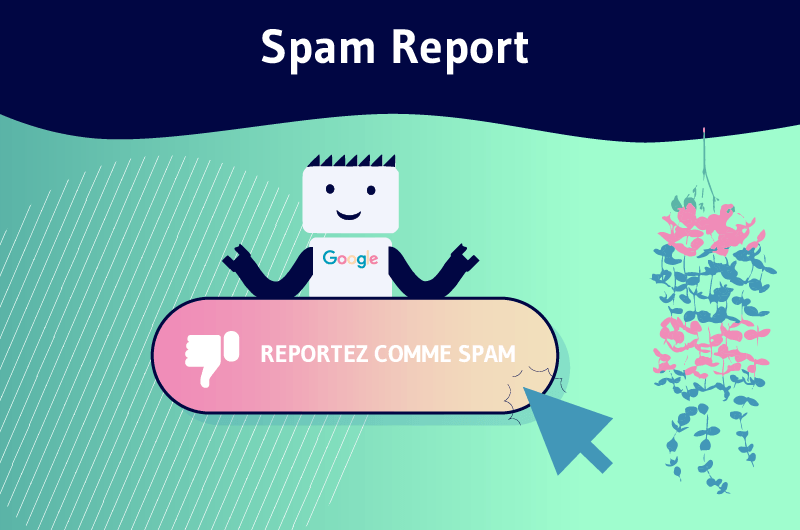Literally, the expression “spam report” means spam report. It refers to the fact that a person reports to Google those who do not respect the good practices of SEO. That is, those who use unauthorized techniques to bypass the search algorithms and get good results in the SERPs
If you take a tour of the Google developers‘ site, it is not uncommon to come across this message
“If you find anything in Google’s search results that you believe appears to be from spam, paid links, malware or other items that may violate our Webmaster Guidelines, click the appropriate link to report the problem.”
This message shows how much Google cares about webmasters following the guidelines it has in place. It is also proof that they have the possibility to indirectly carry out a manual action to punish a site that does not respect the Google guidelines
How does it work in practice?
That’s what I’m going to explain in this article, but first let’s go back to the simplification of the spam report
Chapter 1: What is the spam report?
In this chapter, I will explain in detail what is the spam report. You will also find out why spam report exists
1.1. The spam report
As I have already mentioned, you only need to visit the Google developers’ website to see that you have the possibility to report sites that you think are violating the webmaster guidelines
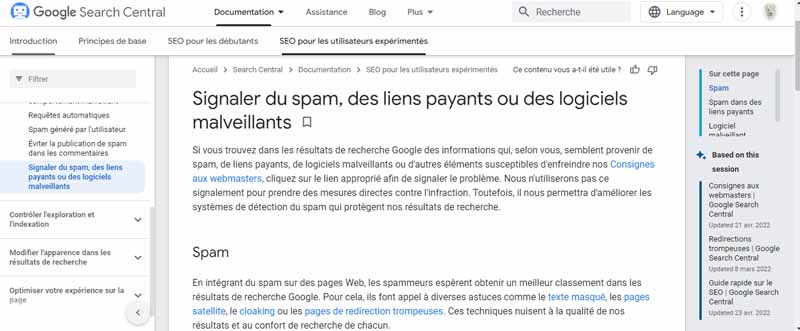
But, although one can think that such a possibility can be used in a haphazard and unnecessary way by competitors, Google reassures by specifying that it will “not use this reporting to take action directly against the infringement”, but only to improve their spam detection systems that protect the search results.
To better understand what we are talking about, it is helpful to know what spam means
Avast defines it as unsolicited, intrusive, annoying, promotional content sent to lots of people whether they ask for it or not
There are several types of spam
- SEO Spam
- Spam by e-mail
- Spam on social networks;
- Mobile Spam;
- Messaging spam.
The type of spam we are interested in here is SEO Spam. This type of spam, also known as spamdexing or abusive optimization, includes the use of a set of prohibited optimization methods on a website. These techniques are also known as black HAT SEO
They aim to quickly place the site that adopts them in a good position in the SERPs
Indeed, it is no secret that SEO requires energy, work, method and time
Also, to have a consistent traffic to a site, it is necessary to be placed in the first results of SERPs, because 75% of clicks are shared between the first three results of the search.
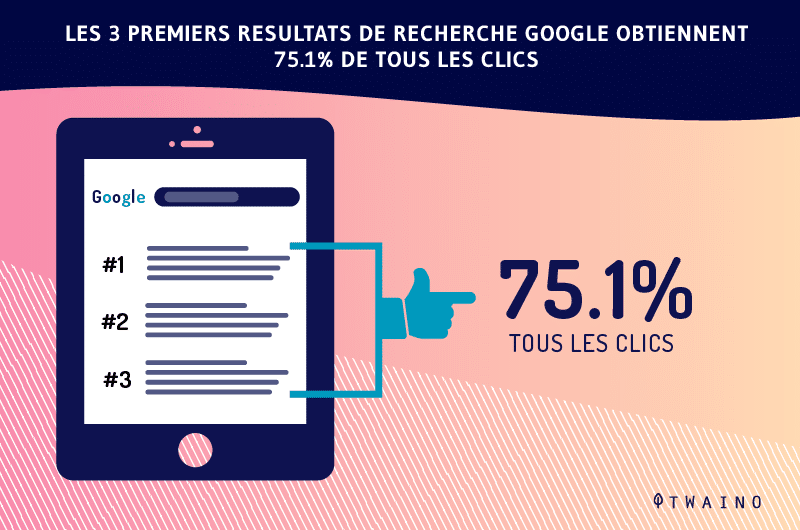
Faced with this dual reality, some webmasters often do not hesitate to resort to black HAT SEO practices to deceive the search engine algorithms and rank among the top results
But, such practices can jeopardize the user experience and overshadow sites that rigorously respect Google guidelines and offer quality content
Such a situation, which is unfair to say the least, is incompatible with the ambition of a search engine such as Google, which aims above all to offer Internet users quality results that best correspond to their search intent
It is precisely in this perspective that the search engine is doing everything possible to fight and sanction sites that engage in such practices. Google, through its quality assessment team, does not hesitate to take manual action against these sites

But since the process of manual actions is not automated and relies mainly on the action of individuals, Google allows both Internet users and webmasters to take part

However, their role is limited to alerting, preventing, reporting to the search engine on the existence of a site or content that implements these prohibited practices: This is the Spam report
1.2. what is the purpose of the spam report
When browsing search results, it is not uncommon to come across pages that offer content that is disappointing in relation to the promise they made in the search results.
Such an experience can be frustrating and negatively impact the user of the search engine
Aware of this, Google has put in place a number of mechanisms to monitor and eliminate from search results websites that exhibit certain characteristics
It has also issued rules as well as quality guidelines to website creators. However, all these measures seem to be insufficient and it still happens that sites with certain irregularities escape all control and are positioned in the SERPs
It is therefore in front of this that Google intends to rely on informed users such as webmasters to alert it and submit spam reports when they encounter sites that do not respect the guidelines?
These reports are not used to directly sanction the websites concerned. They allow, among other things, the improvement of the quality of the results that the search engine offers in the SERPs and ensure the same conditions of competition to webmasters.
Now that you have an understanding of the Spam report, it would be interesting to see in the following lines the practices that are considered as spam by Google
Chapter 2: What are the practices that are considered as spam
Two main types of practices are considered as spam
These are
- Content spam
- And link spam
2.1. Content spam
As the name implies, this is the spam that spammers can integrate on the page of a website in order to better position its content in the search results
This category of spam includes the following practices
2.1.1. Automatically generated content
This is when a website produces its content from an automatic content creation system. These systems generate content automatically. It goes without saying that no quality standards are respected and that the quality will not be there
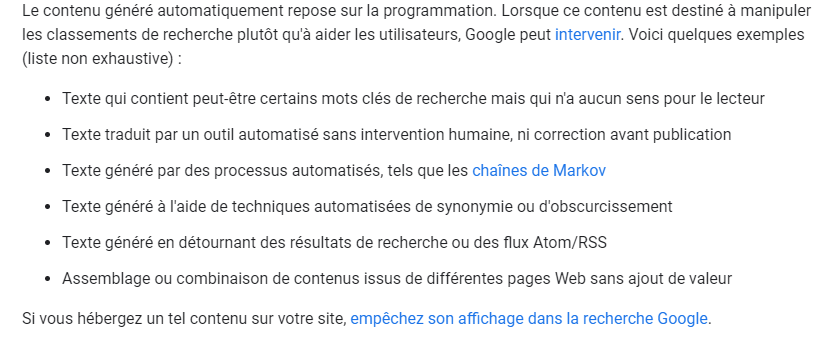
2.1.2. Cloaking
Still called camouflage, cloaking is a strategy that consists in presenting two different texts. One is displayed to the Internet user and the other to search engines

Learn more about the practice of cloaking by consulting the definition I wrote about it.
2.1.3. Hidden text
This is the use of the following practices on a website:
- Using white text on a white background
- Placing a text behind an image;
- Use of CSS code to position text outside the screen
- Setting the font size to 0
- Hiding a link by making it a single small character
2.1.4. Keyword stuffing
Keyword stuffing is a practice that consists of overloading the content of a web page with keywords

2.1.5. The clickbait
It is the fact for a webmaster to use catchy titles to attract users to his site. The objective is to deceive the user and get him to perform an action.

2.2. Link spam
The practices under discussion here are those that are set up on a site and whose objective is to manipulate the ranking of the site in the SERPs or Pagerank ranking
As an example, you can have the following practices
- The purchase or sale of links that transfer PageRank
- Buying links or posts containing links
- Exchanging goods or services in exchange for links
- Sending a “free” product in exchange for a comment that includes a link
- Excessive link exchanges (“Add a link to my site and I’ll add a link to yours”) or partner pages used exclusively for cross-linking purposes
- Marketing campaigns via guest articles or blog posts with keyword-rich anchor text links
- Use of automated programs or services to link to your site
- Linking imposed as part of a terms of use, contract or similar arrangement without allowing a third-party content owner the opportunity to describe the outbound link, if they choose
- Questionable redirects: This happens when webmasters try to take advantage of expired domains to avoid losing the traffic that some links generate redirecting to several other types of sites, most of which are unrelated to the original promise.
Besides spam, other practices can be reported as well, these are
2.3. Malicious or unwanted software
Malware is perceived as software whose purpose is to damage a computer or mobile device, disrupt its operation or simply harm its users
In reality, malware is designed to perform harmful behaviors. For example, it can
- Install software on the device without the owner’s consent;
- Collect your confidential data;
- Run viruses
- Negatively affect your browsing experience
- Etc.
2.4. Phishing
Phishing is a technique that consists of deceiving the Internet user into communicating confidential information related to his person or his online accounts
The tactic used is often the creation of a page that looks like the original
These are just a few examples of practices that can lead users to report your site to Google
Now let’s look at how the site can be reported to Google
Chapter 3: How to report a site to Google
In this chapter, I show you how you can inform Google that a site is using Spamdexing practices to rank in search results. After that, I explain how Google reacts
3.1. how to report spamming sites to Google?
When you have detected a page or a website that adopts one of the practices I just presented and you want to report it to Google, you must first have a Google account
Then, you just have to follow the following steps
3.1.1. For content spam
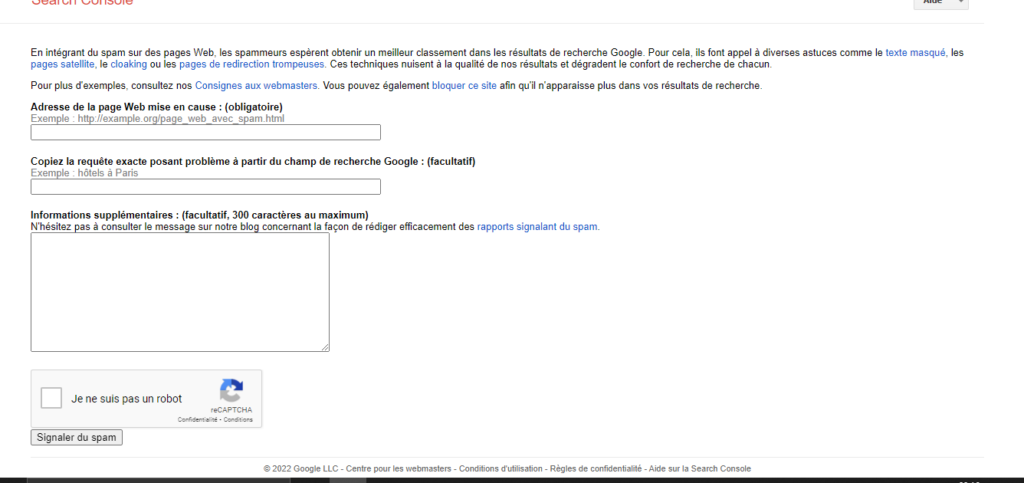
- Click on the appropriate link;
- Fill in the three boxes namely: the address of the web page you are accusing, the search query that revealed the spam to you, written additional information to explain the problem
- Fill in the captcha;
- Finally, press “report spam”
3.1.2. For link spam
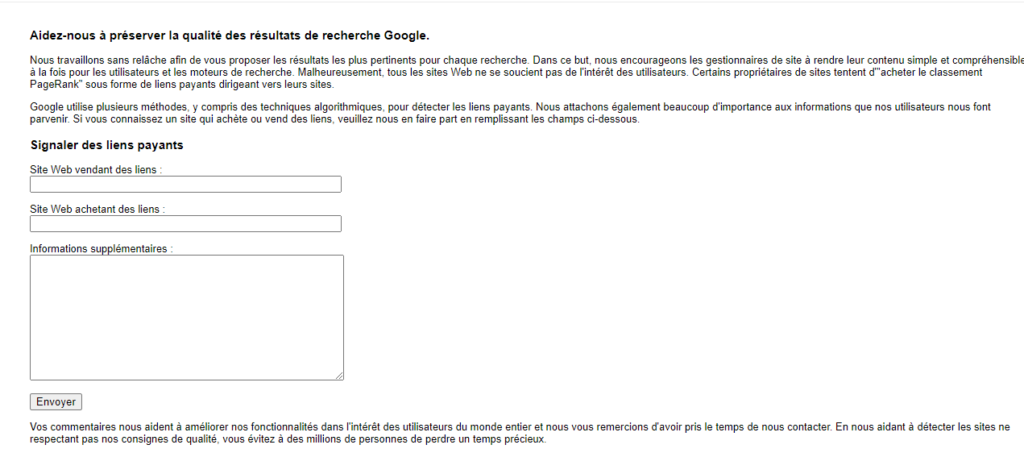
- Click on the link of the form allowing you to report link spam
- Fill in the URL of the selling and buying site in the appropriate boxes
- If possible, add additional information and send
3.1.3. For malware

- Click on the link of the form that corresponds to report malware
- Fill in the URL of the phishing site
- Fill in the Captcha
- Add additional information if possible and submit
3.1.4. For phishing or pishing
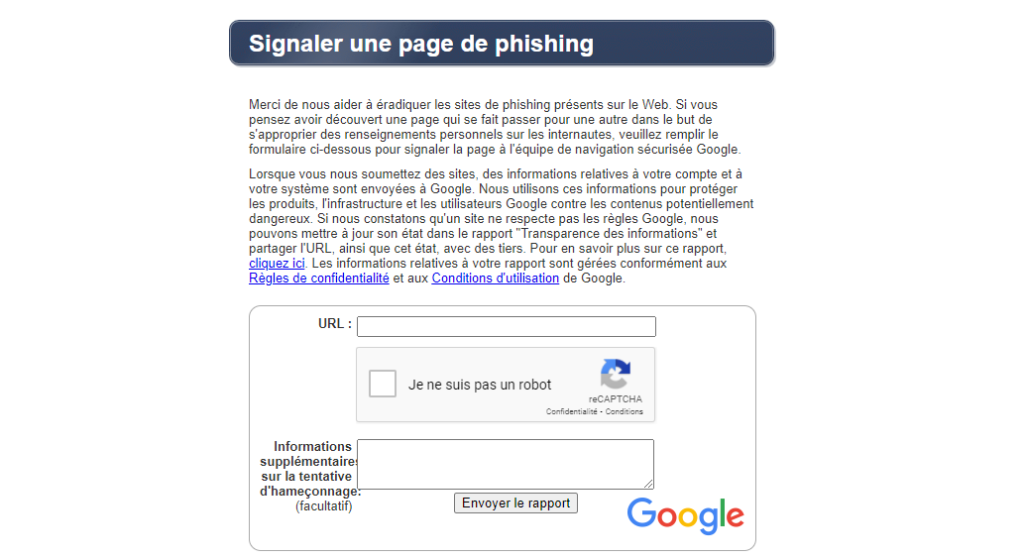
- Click on the link of the form that corresponds to report malware;
- Fill in the URL of the phishing site;
- Fill in the Captcha ;
- Add additional information if possible and submit
Once you submit the spam reports, it’s perfectly legitimate to wonder what happens next. This is exactly what I will explain in the next part
3.2. What happens once you submit the spam reports to Google?
Once you submit the spam reports to Google, Google does not automatically apply a penalty. In fact, the first thing Google does after receiving your spam reports is to verify the information you sent to them
This is a necessary step in order to determine that the report is valid. Such verification also prevents the spam report from being a way for webmasters to get their competitors in trouble
Once the report is verified and it is established that you are right, algorithms are put in place to fight against this practice
On the other hand, this can lead Google to sanction the site in question through manual actions
You can learn more by consulting the definition of twaino on manual actions.
In summary
The spam report is the possibility that Google gives to its webmasters to keep an eye on the respect of the quality guidelines
These spam reports if verified can lead the search engine to implement manual actions on the sites concerned
In this chapter, I have explained what the Spam report is and why it exists. You will also find the practices that can be considered as such and how you can submit them to Google
Have you already reported a site to Google?
Are you planning to do so?
Feel free to share your experiences with me in the comments
See you soon!

